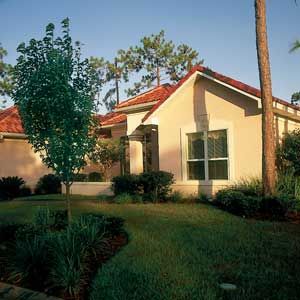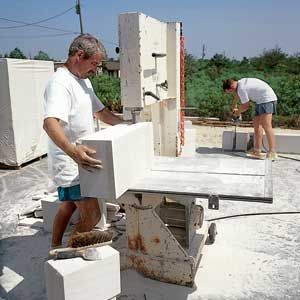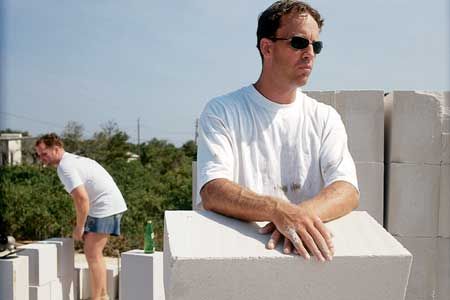
With a pop, Chris Poate lights a pro-pane torch and moves the flame close to what looks like a double-thick slice of white bread. “Watch this,” says the north Florida builder, his voice revealing his Australian roots. He toasts one side of the stuff—called autoclaved aerated concrete (AAC)—until it’s cherry red and then offers the other side to a visitor. The toast is cool. And it’s light—about half the weight of concrete, which it was invented to replace. “That’s just the beginning,” Poate says with a grin. Some call Autoclaved Aerated Concrete (AAC) a near-perfect building material. Patented in 1924 by a Swedish architect, AAC is made of common ingredients: portland cement, lime, silica sand or fly ash, water and a dash of aluminum powder. The material is acoustically insulating, energy conserving, resistant to fire, decay and termites, and can be cut with a handsaw and sculpted into architectural details. Europeans have built a million houses and buildings with AAC, but attempts to introduce it here failed until recently, when energy concerns and high lumber prices started opening minds to its possibilities.
Plaid Bermudas flapping around his tanned legs, Poate jumps out of his van at a house that his firm, Advanced Coastal Construction, is building from AAC. It’s 92 degrees Fahrenheit in the shade along Florida’s Choctawhatchee Bay, but when Poate walks into the unfinished house, the temperature is much cooler, and the construction noise from upstairs hardly penetrates the 10-inch-thick steel-reinforced AAC floor panels. The panels were made by Hebel, a German manufacturer that, in 1996, opened the first AAC factory in this country. (Ytong, a competitor, opened an AAC plant here in 1997.) The home owner, Richard Grenamyer, has wanted an AAC house for a long time. “I read about it years ago, but it wasn’t available,” he says. “A friend had Hebel block shipped from Germany to build his house in Tallahassee. I was excited when I saw the Hebel signs.” What slowed AAC’s arrival in the United States was the reluctance of some masons to learn new work habits, says Bob Shuldes, a consulting engineer at the Portland Cement Association who has studied the material’s history. But watch mason Mark Harrison at work, and it’s hard to see why. “It’s easy,” he says, cutting a block to size on a big band saw and adding it to the waist-high wall at another house on Poate’s tour. Harrison sets down his trowel to pick up one of the AAC blocks. At 24 inches long, it is larger than a typical concrete block and, at about 30 pounds, it is lighter—but because it is solid, Harrison has to use two hands. American masons are used to grabbing the web of a concrete block and hefting it into place with one hand. Harrison doesn’t mind working two-handed, but some masons never get used to the difference.

AAC goes up more quickly than traditional concrete block. And once in place, it’s sturdy, with enough strength in compression to support itself three or four stories high. With roof ties every 12 feet and at the corners, AAC meets the local wind-load requirements of 130 miles per hour, says Poate’s partner Craig Cole. Greater wind-load requirements call only for thicker walls, says architect Giles Blunden, who designed a house built of AAC in Chapel Hill, North Carolina, this year: “We had one wall 14 feet high, so we consulted with an engineer and made it 10 inches thick instead of 8.” Because AAC is still unfamiliar, Hebel and Ytong both offer engineering assistance to designers and builders. The companies also train tradesmen.
Blunden, who has a special interest in energy-efficient construction, says AAC’s cellular spaces make for excellent insulation. Hebel’s calculations indicate that an 8-inch AAC wall has an R-value of 11 but, because of reduced air infiltration and increased thermal mass, it outperforms a stud wall rated at R-30. “You get a flywheel effect from its mass—reduced temperature fluctuation, because it’s slow to heat or cool,” Blunden says. Hebel says its walls are two and a half times more airtight than standard wood frames or concrete blocks—so tight, in fact, says Craig Cole, that another problem arises: balancing the air-conditioning. “A 2,800-square-foot house will stay cool so long that humidity builds up before the air conditioner kicks on,” Cole says. “So we downsize the air-conditioning by a ton and add a humidistat, so either temperature or humidity kicks the unit on.” AAC’s drawbacks come mostly from its novelty. While it can be screwed and nailed as easily as wood, the attachment is often not as strong—screws can strip out, and nails can twist. Plastic anchors help, and Hebel has designed special, large-headed, square-shank cut nails with better holding power. Tiny blemishes can be filled with thin-set mortar, but it drips and runs, so larger repairs require a stiffer mortar. Because water collects in the material’s open pores, AAC can’t be left unfinished for more than a few days.
Here in northern Florida, a one-story Hebel-walled house costs about 2.5 percent more than a comparable frame one with stuccoed 6-inch stud walls, Cole says. But energy savings repay the difference in less than five years, he says. AAC’s higher cost keeps it out of the moderate-priced market, Poate says, because buyers are concerned about up-front costs. Buyers of more expensive houses ($200,000 and up, in this region) “understand the quick payback and are willing to make the investment,” he says, parking the van back at his office in Destin. AAC is already more popular than some predicted. The 80s’ energy crisis revealed the need for an energy-efficient concrete product. When construction codes reflected that need, American builders started trying AAC. And now, says engineer Shuldes, “I’d say it’s here to stay.”

